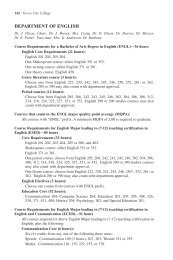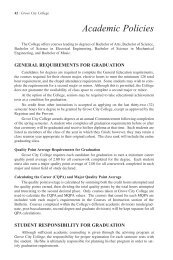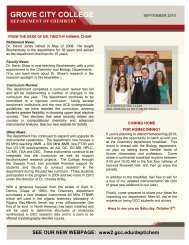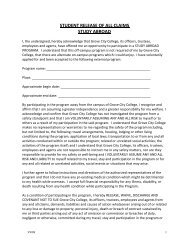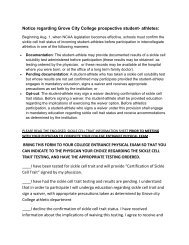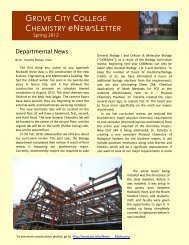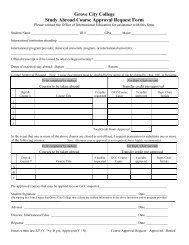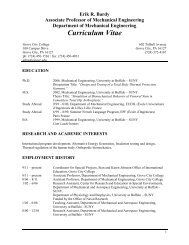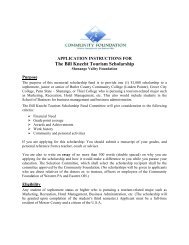A Review of Power-Generating Turbomachines - Grove City College
A Review of Power-Generating Turbomachines - Grove City College
A Review of Power-Generating Turbomachines - Grove City College
You also want an ePaper? Increase the reach of your titles
YUMPU automatically turns print PDFs into web optimized ePapers that Google loves.
In Francis designs the water flows through the penstock into a spiral casing and is directed by a<br />
set <strong>of</strong> guide vanes on to the turbine rotor, called a runner. After flowing through the runner, the<br />
water is discharged into the draft tube. Runner design is determined by certain key variables such<br />
as operating head, required runner speed, speed ratio (blade velocity over fluid velocity), and<br />
required runner output. In the Kaplan turbine, which is an axial-flow design best suited for high<br />
flow rates, water is directed by stay vanes through wicket gates over a propeller turbine. The<br />
propeller typically has five to eight blades. After passing through the blades, the water is<br />
discharged through a draft tube. 44<br />
Figure 6: Voith Hydro schematics <strong>of</strong> the Pelton, Francis, and Kaplan hydraulic turbines (www.voithhydro.de).<br />
3.3 Future Developments and Research<br />
A very important factor in research and development <strong>of</strong> hydraulic turbines is the handling,<br />
reduction, or avoidance <strong>of</strong> cavitation in the flow, which results in decreased power output and<br />
efficiency. Cavitation can also result in unwanted noise and vibration and contributes to gradual<br />
erosive wear <strong>of</strong> the machinery, or even sudden catastrophic failure. 19<br />
Key to research efforts is the application <strong>of</strong> computational fluid dynamics (CFD), which began<br />
about 30 years ago. CFD analysis has progressed in stages from 3D Euler solutions, to steady<br />
RANS simulations using finite volume methods, to the present state <strong>of</strong> solving unsteady RANS<br />
equations with advanced turbulence models. 21 Now these tools are being developed to<br />
incorporate two-phase flows, as in cavitation and free surface flow in Pelton turbines, the flow<br />
simulation <strong>of</strong> which is considered “by far the most complex and difficult <strong>of</strong> all hydraulic<br />
turbomachinery simulations”. 22<br />
Research is also prevalent on reaction turbines, which are generally considered more prone to<br />
cavitation than impulse turbines. Researchers have applied these tools to the analysis and flow<br />
simulation <strong>of</strong> Francis turbines with promising results that are beginning to converge and accord<br />
with the experimental data. 23 Researchers are also carrying out investigations on the acoustical<br />
properties <strong>of</strong> cavitation in order to develop equipment monitoring systems that will accurately<br />
estimate erosion level in the turbine. 24<br />
4.0 Ocean Energy Turbines (Tidal and Wave)<br />
4.1 Past<br />
The oceans <strong>of</strong> the earth represent an attractive alternative energy source. This source is<br />
nonpolluting, more predictable than wind and solar, and vastly abundant. In fact, “The projected<br />
available ocean power far exceeds the ultimate energy consumption <strong>of</strong> mankind”. 25 Worldwide<br />
Proceedings <strong>of</strong> the 2012 ASEE North Central Section Conference<br />
Copyright © 2012, American Society for Engineering Education<br />
6



